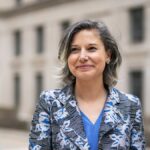
–>
July 18, 2022
Our nation’s media is saturated with opinion concerning the ideological influences on our college and university campuses. This issue, however, is equally present, and perhaps even more intellectually destabilizing, in our secondary education institutions — even in so-called private ones. An example is the Watkinson School in Hartford, Connecticut.
‘); googletag.cmd.push(function () { googletag.display(‘div-gpt-ad-1609268089992-0’); }); }
I had the benefit of attending the private college preparatory Watkinson School (from 1975 until I graduated in 1977, both with a secondary education or “High School” diploma, and a diploma in creative arts performance in conjunction with the next door Hartt College of Music at the University of Hartford). The school back then was much more conservative, where by “conservative” I mean aware of, and still confidently informed by, certain strong and functional traditions.
Conservative also means some leaning toward faith. While the Christian faiths were explicit in Watkinson’s founding culture, we also had many other religions or variants on campus, including Jewish, Baptist, Muslim, and devoted agnostics. We had nearly every race and “orientation” on campus as well, from White Anglo-Saxons, to African-American, Indian, Hispanic, straight and “gay.” And you know what? None of us even thought about it. We all got along; we all laughed, played sports, chamber music and jazz, debated — and socialized. There was no “diversity” director, nor any speech guidelines other than civility (there was a dress code which as I look back wasn’t a bad idea). But we also had a healthy respect and enjoyment of the “opposite sex” and developing our identities as men and women were critical to also developing America’s strength and culture, in part because they define the most important unit of economics and democracy: the family.
I wonder, however, how many young Watkinson students even know about this history? How many have made the effort to visit the (still standing) factory buildings in the nearby town of Collinsville that Watkinson’s founding family built? What culture of capital enterprise and entrepreneurship is recognized today by Watkinson’s faculty and administration? With my bias acknowledged, I would say the spirit is still strong among the intellectually uncontaminated young adults who now go there — and the School’s record in college placement is enviable.
‘); googletag.cmd.push(function () { googletag.display(‘div-gpt-ad-1609270365559-0’); }); }
The school’s culture wasn’t shy about some of its religious roots, as the original “shield” (now replaced with a “thumbprint”) contains a symbol of the cross, and a descending dove, the image of Christ. The images are also surrounded with a Latin quote from Servatus Lupus, (Epistulae 1) which reads propter se ipsam appetenda sapientia, which translates as “wisdom for its own sake.”
I was thinking about what this really means, including in my capacity as a college parent, and while it points to a non-utilitarian philosophy of knowledge, it also may indicate a pursuit of learning that is uncorrupted by “hermeneutics” or interpretative methodology and ideologies: no one has to tell you how to cultivate information and understanding, and it leads to wherever it leads; it is unfiltered, perhaps “libertarian” in its larger meaning by the words “its own sake.” That is, not for the sake of special interests, social groups, political affiliations, or other “Groupthink” influences.
All this is a way of getting to a recent mailing I received from the school concerning “diversity” and the appointment of a Diversity Director. I started to wonder: why one is even needed? Is this for the students, or perhaps for the faculty and administrators (and the State of Connecticut, federal government, and college admissions directors)? Young adults do not inherently activate other concepts and categories of natural identity, except by what they may be taught. Moreover, the cognate disciplines, the fine arts or sports, know of no such distinctions but by what may be imposed. But these are imposed by adults, and my thesis is that the imposition is not only more dangerous at the secondary school level, but is the reason why students arrive on our university and college campuses, with some exceptions, largely indoctrinated and sensitized already (a law school professor in Chicago related to me how his college graduate students come into law nearly rigid in their obsessions of identitarianism and progressive bias, reinforced of course by the vast majority of faculty). The Watkinson Diversity Director’s kickoff agenda was larded with all the current consensus ideology and language usage, and organized the use of all the terms of art: “best practice for affinity groups;” the “significance and power of names;” correctly identifying “microaggressions,” along with a “Day of Community and Belonging” and an annual “Social Justice Day” and of course “equity.”
What does this mean for the way we are developing our nation’s new young Americans? What values do they embody? How robust and durable is their ability to engage in disciplined perception, rather than thoughtless rhetoric? How susceptible are they to the influences of political manipulation and persuasion, and can they recognize when they are being manipulated? What happens to them when a “diversity” hysteria promotes and reinforces racial division, stereotyping, classification and in-group/out-group sociology? Recent Watkinson student essays include “In The Eyes of The Colonizer: How The White Gaze Has Impacted The POC View of Beauty” and “Black Women and Stigmas Regarding Mental Health.” This may not only be dangerous in its dimensions of intellectual and emotional immaturity, and victimhood culture and dependency, but is a symptom in the larger loss of genuine personal identity, a surrender to authority preferences and “Groupthink,” and a splintering of psychological functioning that stems from a young adult who is merely “parroting” encouraged language (Yale experimental psychologist Stanley Milgram called this phenomenon the “Cyranic Illusion” where “a cyranoid is created by cooperatively joining in real-time the body of one person with speech generated by another via covert speech shadowing”). Are our country’s educators acting as speech and thought “shadowers” who are perhaps unwittingly putting these ideas into the impressionable heads of our students? I think so. Faculty and administrators are themselves so directed through their institutionalism, and their obedience to political and state direction.
The last two years especially, have delivered a barrage of very difficult external events that are challenging for young adults to process. They include the uncontrolled hysteria and violence stemming from promotion of the “George Floyd” event, to the summer of violence across many of our cities. This was accompanied by the COVID construct (or “covidianism”) and the extraordinary state penetration into mass behaviors. These were not only merely reported or discussed on our secondary and college campuses, but the schools themselves led the way with explicit, reinforced messaging and programming: the administrators and faculty especially, fell fully for the deceptive nature of these social programming and manipulation techniques, and all but a precious minority of students even, bothered to ask the most fundamental question that underpins all classical liberal education, and philosophy itself: Why?
Finally, the implications in law and policy are poignant: The U.S. Constitution is barely recognizable to most students, and even among the faculty in our nation’s law schools, to which many students aspire, some of its most central tenets are utterly misunderstood and appropriated. The 14th Amendment is perhaps the poster child of leftist confusion, and is thought to give license to an unlimited pursuit of equity claims. As Reagan Solicitor General of the United States, Associate Justice of the Supreme Judicial Court of Massachusetts, and Harvard Law professor Charles Fried crucially reminds our young adults, “The Equal Protection Clause affirmed that the Constitution protected the situations of individuals, not groups. A whole elite cadre depends on racial division for its constituency and its position. But if we continue to divide ourselves by race, to make race dispositive in all sorts of contexts, with the ugly necessity of formally assigning individuals to particular racial groups, then the time will soon come when this new racial segmentation will become permanent, that the ideal of each person’s being judged as an individual and not as a member of a group to which he is assigned by somebody’s “public policy” will no longer be possible.”
‘); googletag.cmd.push(function () { googletag.display(‘div-gpt-ad-1609268078422-0’); }); } if (publir_show_ads) { document.write(“
This has great weight in America’s global competitiveness, as our current social divisions and distractions may be leaving us behind.

Image: NY Public Library Public Domain Collection
<!– if(page_width_onload <= 479) { document.write("
“); googletag.cmd.push(function() { googletag.display(‘div-gpt-ad-1345489840937-4’); }); } –> If you experience technical problems, please write to [email protected]
FOLLOW US ON
<!–
–>
<!– _qoptions={ qacct:”p-9bKF-NgTuSFM6″ }; ![]() –> <!—-> <!– var addthis_share = { email_template: “new_template” } –>
–> <!—-> <!– var addthis_share = { email_template: “new_template” } –>





